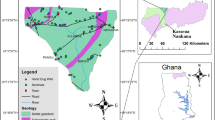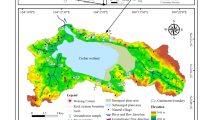Abstract
The contamination of NO3− in groundwater is a global concern, requiring the identification of biogeochemical transformations and sources of nitrate (NO3−) to understand the different nitrogen (N) pathways. This is necessary for the regulation of dispersed pollution of groundwater caused by livestock and agricultural activities. Jinan, located in eastern China, serves as a suitable case study due to its reliance on karst groundwater as a water source and its significant population, industrial, and agricultural development, which pose a substantial risk of nitrogen pollutants in groundwater. Therefore, this study aims to investigate NO3− concentrations and isotopic compositions of N and oxygen in karst groundwater in Jinan City, Shandong province, eastern China, to determine the most significant sources and transformations of NO3−. Approximately 86% of the groundwater samples exceed the NO3−–N standard for drinking water proposed by the World Health Organization (WHO). Furthermore, chemical indicators (Cl−, HCO3−, and TDS) and the oxygen and nitrogen isotopic compositions of NO3− indicate that soil organic nitrogen, manure, and urban sewage are the main sources of NO3− in the groundwater. Isotopic analyses also suggest that various biogeochemical transformations, such as nitrification and volatilization, occur throughout the study area, with microbial nitrification being the dominant process in water resource areas with high NO3− concentrations. To reduce NO3− pollution in the Changqing–Xiaolipu water supply, several suggestions have been proposed.







Similar content being viewed by others
Data availability
The data presented in this study are available on request from the corresponding author.
References
Acevedo Peralta AI, Leos Rodríguez JA, Figueroa Viramontes U, Romo Lozano JL (2017) Política ambiental: uso y manejo del estiércol en la Comarca Lagunera. Acta Universitaria 27(4):3–12
Andersson KK, Hooper AB (1983) O2 and H2O are each the source of one O in NO− 2 produced from NH3 by Nitrosomonas: 15N-NMR evidence. FEBS Lett 164(2):236–240
Boonsaner M, Hawker DW (2013) Evaluation of food chain transfer of the antibioticoxytetracycline and human risk assessment. Chemosphere 93:1009–1014
Böttcher J, Strebel O, Voerkelius S, Schmidt HL (1990) Using isotope fractionation of nitrate-nitrogen and nitrate-oxygen for evaluation of microbial denitrification in a sandy aquifer. J Hydrol 114(3–4):413–424
Cable E, Deng YW (2018) Trace elements in atmospheric wet precipitation in the Detroit metropolitan area: levels and possible sources. Chemosphere 210:1091–1098
Clark ID, Fritz P (1997) Environmental isotopes in hydrogeology. CRC Press
Dan-Hassan MA, Olasehinde PI, Amadi AN, Yisa J, Jacob JO (2012) Spatial and temporal distribution of nitrate pollution in groundwater of Abuja. Nigeria. https://doi.org/10.5539/ijc.v4n3p104
Di Lorenzo T, Brilli M, Del Tosto D, Galassi DM, Petitta M (2012) Nitrate source and fate at the catchment scale of the Vibrata River and aquifer (central Italy): an analysis by integrating component approaches and nitrogen isotopes. Environ Earth Sci 67:2383–2398
Erisman JW, Galloway JN, Seitzinger S, Bleeker A, Dise NB, Petrescu AR, Leach AM, de Vries W (2013) Consequences of human modification of the global nitrogen cycle. Philos Trans R Soc B 368(1621):20130116
Figueroa Viramontes U, Núñez Hernández G, Reta Sánchez DG, Flores López HE (2015) Balance regional de nitrógeno en el sistema de producción leche-forraje de la Comarca Lagunera, México. Revista Mexicana De Ciencias Pecuarias 6(4):377–392
Fukada T, Hiscock KM, Dennis PF, Grischek T (2003) A dual isotope approach to identify denitrification in groundwater at a river-bank infiltration site. Water Res 37(13):3070–3078
Galloway JN (2003) The global nitrogen cycle. Treatise on Geochemistry, pp 557–583
Guo Z, Yan C, Wang Z, Xu F, Yang F (2020) Quantitative identification of nitrate sources in a coastal peri-urban watershed using hydrogeochemical indicators and dual isotopes together with the statistical approaches. Chemosphere 243:125364
Jiang Z, Lv L, Zhang W, Du Q, Pan B, Yang L, Zhang Q (2011) Nitrate reduction using nanosized zero-valent iron supported by polystyrene resins: role of surface functional groups. Water Res 45(6):2191–2198
Jørgensen PR, Urup J, Helstrup T, Jensen MB, Eiland F, Vinther FP (2004) Transport and reduction of nitrate in clayey till underneath forest and arable land. J Contam Hydrol 73(1–4):207–226
Ju XT, Xing GX, Chen XP, Zhang SL, Zhang LJ, Liu XJ, Cui ZL, Christie P, Zhu ZL, Zhang FS (2009) Reducing environmental risk by improving N management in intensive Chinese agricultural systems. Proc Natl Acad Sci 106(9):3041–3046
Kaushal SS, Groffman PM, Band LE, Elliott EM, Shields CA, Kendall C (2011) Tracking nonpoint source nitrogen pollution in human-impacted watersheds. Environ Sci Technol 45(19):8225–8232
Kendall, C. (1998). Tracing nitrogen sources and cycling in catchments. In: Isotope tracers in catchment hydrology, pp 519–576
Kohn J, Soto DX, Iwanyshyn M, Olson B, Kalischuk A, Lorenz K, Hendry MJ (2016) Groundwater nitrate and chloride trends in an agriculture-intensive area in southern Alberta, Canada. Water Qual Res J Can 51(1):47–59
Lee KS, Bong YS, Lee D, Kim Y, Kim K (2008) Tracing the sources of nitrate in the Han River watershed in Korea, using δ15N-NO3− and δ18O-NO3− values. Sci Total Environ 395(2–3):117–124
Li SL, Liu CQ, Li J, Liu X, Chetelat B, Wang B, Wang F (2010) Assessment of the sources of nitrate in the Changjiang River, China using a nitrogen and oxygen isotopic approach. Environ Sci Technol 44(5):1573–1578
Li JG, Xie ZY, Qiu XC, Yu Q, Bu JW, Sun ZY, Long RJ, Brandis KJ, He J, Feng Q, Ramp D (2022) Heavy metal habitat: a novel framework for mapping heavy metal contamination over large-scale catchment with a species distribution model. Water Res 226:119310
Nestler A, Berglund M, Accoe F, Duta S, Xue D, Boeckx P, Taylor P (2011) Isotopes for improved management of nitrate pollution in aqueous resources: review of surface water field studies. Environ Sci Pollut Res 18:519–533
Nikolenko O, Jurado A, Borges AV, Knӧller K, Brouyѐre S (2018) Isotopic composition of nitrogen species in groundwater under agricultural areas: a review. Sci Total Environ 621:1415–1432
Ogrinc N, Tamše S, Zavadlav S, Vrzel J, Jin L (2019) Evaluation of geochemical processes and nitrate pollution sources at the Ljubljansko polje aquifer (Slovenia): a stable isotope perspective. Sci Total Environ 646:1588–1600
Rao NS (2006) Nitrate pollution and its distribution in the groundwater of Srikakulam district, Andhra Pradesh, India. Environ Geol 51:631–645
Saccon P, Leis A, Marca A, Kaiser J, Campisi L, Böttcher ME, Savarino J, Escher P, Eisenhauer A, Erbland J (2013) Determination of nitrate pollution sources in the Marano Lagoon (Italy) by using a combined approach of hydrochemical and isotopic techniques. Procedia Earth Planetary Sci 7:758–761
Shalev N, Burg A, Gavrieli I, Lazar B (2015) Nitrate contamination sources in aquifers underlying cultivated fields in an arid region–The Arava Valley, Israel. Appl Geochem 63:322–332
Sun B, Xing LT, Li CS (2018) Variation of typical pollution components and pollution way of karst water in Baotu Spring region. Carsologica Sinica 37:810–818
Taiwo AM, Harrison RM, Shi ZB (2014) A review of receptor modelling of industrially emitted particulate matter. Atmos Environ 97:109–120
Vitòria L, Otero N, Soler A, Canals A (2004) Fertilizer characterization: isotopic data (N, S, O, C, and Sr). Environ Sci Technol 38(12):3254–3262
Vitòria L, Soler A, Canals À, Otero N (2008) Environmental isotopes (N, S, C, O, D) to determine natural attenuation processes in nitrate contaminated waters: example of Osona (NE Spain). Appl Geochem 23(12):3597–3611
Wang JJ (2016) Numerical model of karst groundwater in Jinan and the Houzumi water supply management model. Shandong University
Wexler SK, Hiscock KM & Dennis PF (2009) Tracing the sources and fate of diffuse nitrate contamination in a lowland agricultural catchment using a dual-isotope method. In: EGU General Assembly Conference Abstracts, 691
Widory D, Petelet-Giraud E, Négrel P, Ladouche B (2005) Tracking the sources of nitrate in groundwater using coupled nitrogen and boron isotopes: a synthesis. Environ Sci Technol 39(2):539–548
World Health Organization (2017) Guidelines for drinking-water quality: first addendum to the fourth edition
Xue D, Botte J, De Baets B, Accoe F, Nestler A, Taylor P, Van Cleemput O, Berglund M, Boeckx P (2009) Present limitations and future prospects of stable isotope methods for nitrate source identification in surface-and groundwater. Water Res 43(5):1159–1170
Yu D, Yu J, Wu D, Han Y, Sun B, Zheng L, Chen H, Liu R (2023) Isotopic and hydrochemical characteristics of the Changqing-Xiaolipu water resource, Jinan, Eastern China: implications for water resources in the Yellow River Basin. Sustainability 15(3):2439
Yuan DX, Jiang YJ, Shen LC, Pu JB, Xiao Q (2016) Modern karstology. Science Press, Beijing
Acknowledgements
This research was supported by the National Natural Science Foundation of China (Grant Nos. 42102076) and project ZR2021QD037 supported by Shandong Provincial Natural Science Foundation. We especially thank anonymous reviewers for their valuable and constructive comments.
Author information
Authors and Affiliations
Contributions
Y.F Zhang, D.L Yu, D. Wu, Y.H Zhao, Z. Zhang, B. Li and R. Liu wrote the main manuscript text; B.H Huang, M.G Wang, J.R Gao and Y.X Kang prepared figures 1-6.
Corresponding authors
Ethics declarations
Conflict of interest
The authors declare no competing interests.
Additional information
Publisher's Note
Springer Nature remains neutral with regard to jurisdictional claims in published maps and institutional affiliations.
Rights and permissions
Springer Nature or its licensor (e.g. a society or other partner) holds exclusive rights to this article under a publishing agreement with the author(s) or other rightsholder(s); author self-archiving of the accepted manuscript version of this article is solely governed by the terms of such publishing agreement and applicable law.
About this article
Cite this article
Zhang, Y., Yu, D., Wu, D. et al. Tracing nitrate pollution sources of karst groundwater in water resources using environmental isotopes. Carbonates Evaporites 38, 80 (2023). https://doi.org/10.1007/s13146-023-00906-5
Accepted:
Published:
DOI: https://doi.org/10.1007/s13146-023-00906-5




